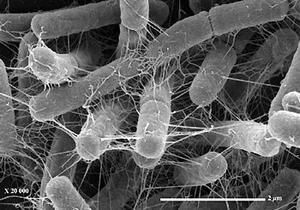Okay, so this may gross out some of you, but it is really interesting (if not slightly terrifying when you try to figure out how we are still walking around and haven’t been taken over by bacteria).
Bacteria in biofilm grow as communities, not single cells. They are very resistant to our body’s defenses. One of the first defenses your body sends in to attack an intruder is the phagocyte. It is a white blood cell which comes in and finds the intruder. It will bind to it, engulf it, release enzymes to attack it. It calls in its friends to let them know your body is under attack.
Phagocytes can’t get rid of biofilm. The scientists discuss something called “frustrated phagocytes.” They try and try to get rid of the bacteria in the biofilm. And they get madder and madder. And they release more enzymes. Many think this is what leads to bone breakdown around prosthesis. We know injecting steroids can help sometimes with this. Why? It is calming down those angry, frustrated phagocytes.
Biofilm bacteria are colonies of different bacteria which are LINKED. (This is the scary part.) They have intercommunications which share cytoplasm- so they exchange DNA, including resistance to antibiotics. There are also electrical connections. They showed a study where one end of a biofilm was exposed to an antibiotic, and within seconds the whole biofilm reacted, even those parts far away from where the antibiotic was.

Eek.
When you do cultures, you can’t culture the biofilm. It is stuck like tape onto your body. Cultures only can get the one or two bacteria which have been shed off and are floating in your blood or saliva. The biofilm scientists believe cultures are misleading us. They can only detect the floaters. And the dose of antibiotic which kills the floaters is much less than that needed to kill the biofilm. 1000X less.
Egads.
This whole thing is much more complex. We need bacteria. We have good bacteria. Somehow, with all of this stuff we are discovering, we are still walking around talking, eating, dancing, and working. Somehow we are still here. And we get a bad cold or sinus infection, and we heal. Sometimes with antibiotics, sometimes without. We have a lot to learn. As I have discussed in other blogs, we need to separate out which bacteria are bad and make us sick, and which ones are okay.
Biofilm is interesting. I think it will be a integral part of improving how we treat infections, and how we approach implantable devices in our bodies- from hip replacements to cardiac valves to breast implants.
